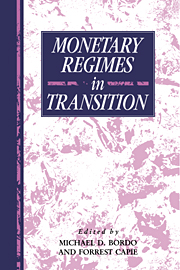Book contents
- Frontmatter
- Contents
- List of figures
- List of tables
- List of contributors
- 1 Introduction
- Part I Commodity money standards in transition
- Part II Successful and unsuccessful adherence to the gold standard
- Part III Wartime upheaval and postwar stabilization
- 8 British and French finance during the Napoleonic Wars
- 9 Interpreting a change in monetary policy regimes: a reappraisal of the first Hungarian hyperinflation and stabilization, 1921–28
- 10 Halting inflation in Italy and France after the Second World War
- 11 The rise and fall of credit controls: the case of Sweden, 1939–89
- Part IV Perspectives on monetary regimes
- Index
8 - British and French finance during the Napoleonic Wars
Published online by Cambridge University Press: 05 May 2010
- Frontmatter
- Contents
- List of figures
- List of tables
- List of contributors
- 1 Introduction
- Part I Commodity money standards in transition
- Part II Successful and unsuccessful adherence to the gold standard
- Part III Wartime upheaval and postwar stabilization
- 8 British and French finance during the Napoleonic Wars
- 9 Interpreting a change in monetary policy regimes: a reappraisal of the first Hungarian hyperinflation and stabilization, 1921–28
- 10 Halting inflation in Italy and France after the Second World War
- 11 The rise and fall of credit controls: the case of Sweden, 1939–89
- Part IV Perspectives on monetary regimes
- Index
Summary
The Napoleonic Wars offer an experiment unique in the history of wartime finance. While Britain was forced off the gold standard and endured a sustained inflation, France remained on a bimetallic standard for the war's duration. For wars of comparable length and intensity in the nineteenth and twentieth centuries, Napoleonic war finance stands out. As Friedman (1990) pointed out, the French experience is a puzzle. Under the ancien régime and the revolutionary governments, France's credit was far inferior to Great Britain's; yet, in the years of bitter struggle after 1796, it was the British who used inflationary finance, not the French.
This apparent paradox may be explained by drawing upon the new literatures on tax smoothing, time consistency, and credibility in macroeconomics. Before the Revolution, French fiscal policy strongly resembled the British practice where large temporary increases in wartime expenditures were paid for by increased borrowing, leaving taxes relatively unchanged. This was a relatively efficient strategy for war finance, but its success hinged critically on the credibility of the government to repay its accumulated and enlarged debt after the war. If the government was perceived by the public to be pursuing a time inconsistent policy, that is, a policy likely to produce default once the debt is acquired, this avenue of war finance would have been closed. The French monarchy was not as credible a borrower as the British parliament and consequently was forced to borrow at higher interest rates for the same program of war finance.
- Type
- Chapter
- Information
- Monetary Regimes in Transition , pp. 241 - 273Publisher: Cambridge University PressPrint publication year: 1993
- 1
- Cited by



